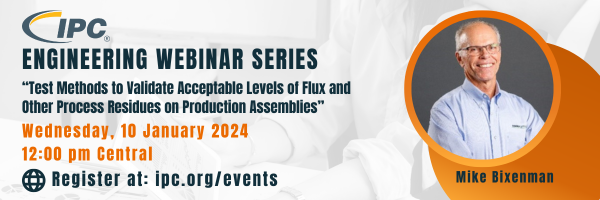Test Methods to Validate Acceptable Levels of Flux and Other Process Residues on Production Assemblies
Electronics manufacturers aim to minimize the amount of flux residues. Solder flux residues constitute a significant source of ionic contamination on the manufactured PCBAs, and the activator type in the flux determines their corrosiveness. The risk occurs on low standoff components, such as the QFN, due to blocked flux outgassing channels. The second risk is the number of soldering process steps used to build the assembly. Selective soldering, wave soldering, manual, and rework soldering can spread flux residues across the assembly. Pockets of active residue can be present when the flux is not fully heat-activated. For high reliability, the best practice is to clean the assembly.
This webinar will teach best practices for qualifying and validating acceptable electrical hardware performance. The methods taught during this presentation can be used to meet the requirements of IPC J-STD-001H ~ Section 8: Cleanliness.

Speaker Bio
Dr. Mike Bixenman, Chief Technology Officer (CTO) and co-founder of KYZEN Corp. and Magnalytix, LLC, has over 30 years of experience designing electronic assembly cleaning materials and process integration. Sharing his research, knowledge, and expertise is Mike’s passion. He believes in the power of collaboration by working with others to solve problems quickly. An active member of several industry associations, he has chaired and led many committees, symposiums, and task groups committed to understanding the cleaning and reliability challenges of today’s ever-changing electronics industry. Dr. Bixenman holds four earned degrees, including a Doctorate in Business Administration (DBA).

